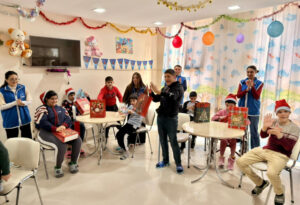Bibi Heybat Mosque of Baku

The Great Leader and then President Heydar Aliyev ordered the construction of a new building for Bibi Heybat Mosque at the same place where it was destroyed
The Bibi Heybat Mosque is a historic mosque located in Baku, the capital city of Azerbaijan. It holds significant religious and cultural importance for the country.
The mosque, built in 1990s, is a restored version of the same mosque, built by the twenty-eighth ruler of the Shirvanshahs, during the second half of 13th century by Azerbaijan’s Elkhanid state, by Abu Fath Farrukhzad ibn Akhsitan ibn Faiburz.
The original Bibi Heybat Mosque was built by Mahmud ibn Sad in the 13th century, but it was completely destroyed by the Bolsheviks in the 1936. The current mosque is a recreation of the original structure and was built in 1994-1998 after Azerbaijan gained independence from the Soviet Union.
Architecture of Bibi Heybat Mosque
From 1305 to 1313, Mahmud Ibn Saad built the mosque’s minarets. The top of the thread and stalactites, raised by a small pillar, surmounted by a semicircular dome of Rebrov. Railing minarets were patterned with stone grill. Graphic studies showed that the height of the minaret was about 22 m.
The old mosque was located in the southern part of the tomb, while there was a 20 meter high minaret in the west part of the mosque. Later a crypt and two niches were added to the mosque to the south of the minaret. On the niches there were inscriptions containing the name Fatali Khan, whose tombstone marble slab is now in the State Museum of History.
The Bibi Heybat Mosque showcases traditional Azerbaijani architectural elements. It follows the design of the 13th-century mosque and features a large central dome, minarets, and intricate decorative details. The exterior of the mosque is predominantly white, while the interior is adorned with colorful tiles.
It is considered to be the tomb of Ukeyma Khanum, a descendant of the Prophet Muhammad P.B.U.H.
Ukeyma Khanum, was a historical figure who holds significance in Azerbaijani history and is associated with the Bibi-Heybat Mosque.
Ukeyma Khanum is associated with the Bibi Heybat Mosque in Baku. According to popular belief, she was buried at the site where the mosque stands today. The mosque is considered to be her tomb, and it has become a place of pilgrimage for Muslims who visit to pay their respects.
The Azerbaijani poet Abbasgulu Agha Bakikhanov, famous French writer Alexander Duma and daughter of Mehdigulu khan Javanshir, Khurshidbanu Natavan, the famous poetess of the Karabakh khanate visited this mosque.
The rich interior of the complex was decorated with ornaments. The interior of the mosque is an oblong rectangular room with a lancet arch. Under the dome, there were chandelier-candlestick, and a hook on which it hung was surrounded by stained glass.
Restoration and current architecture
In 1994, the great leader and then President Heydar Aliyev ordered the construction of a new building for Bibi Heybat Mosque at the same place where it was destroyed.
A dedication ceremony, attended by President Heydar Aliyev, was held on July 11, 1997. The mosque was reconstructed and enlarged by the Presidential decree in 2005. New halls have been constructed to insure the convenience of pilgrims.
The modern restored mosque is a classic example of the Shirvan architectural school. The mosque has three domes, which have kept the traditional corrugated galvanised iron shape of the old mosque and two minarets.
The domes are decorated with the green and turquoise mirrors, which are bordered with gilded inscriptions from Qur’an. The men’s praying room is located on the south side of the complex, while women – on the north side. Between them is the mausoleum.
The architecture of the Bibi Heybat Mosque combines elements of traditional Azerbaijani design with Islamic architectural influences, resulting in a visually stunning and culturally significant structure.


